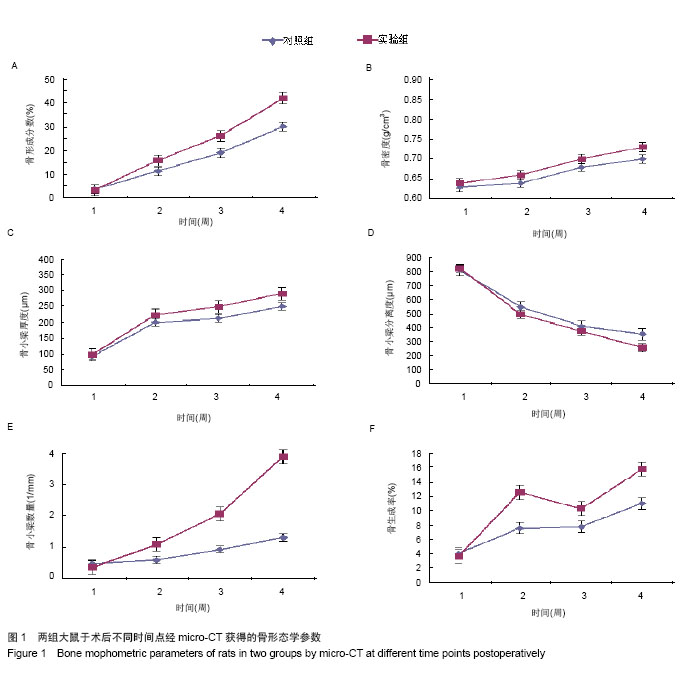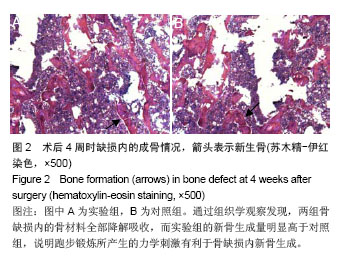| [1]Arrington ED, Smith WJ, Chambers HG,et al. Complications of iliac crest bone graft harvesting.Clin Orthop Relat Res. 1996;(329):300-309.
[2]Grauer JN, Beiner JM, Kwon B,et al.The evolution of allograft bone for spinal applications.Orthopedics. 2005;28(6): 573-579.
[3]Porter JR, Ruckh TT, Popat KC.Bone tissue engineering: a review in bone biomimetics and drug delivery strategies. Biotechnol Prog. 2009;25(6):1539-1560.
[4]Forwood MR, Owan I, Takano Y,et al. Increased bone formation in rat tibiae after a single short period of dynamic loading in vivo.Am J Physiol. 1996;270(3 Pt 1):E419-423.
[5]Turner CH, Forwood MR, Otter MW.Mechanotransduction in bone: do bone cells act as sensors of fluid flow. FASEB J. 1994;8(11):875-878.
[6]Tanaka SM, Sun HB, Roeder RK,et al.Osteoblast responses one hour after load-induced fluid flow in a three-dimensional porous matrix.Calcif Tissue Int. 2005;76(4):261-271.
[7]Zhao F, Chella R, Ma T.Effects of shear stress on 3-D human mesenchymal stem cell construct development in a perfusion bioreactor system: Experiments and hydrodynamic modeling. Biotechnol Bioeng. 2007;96(3):584-595.
[8]Song G, Ju Y, Shen X,et al.Mechanical stretch promotes proliferation of rat bone marrow mesenchymal stem cells. Colloids Surf B Biointerfaces. 2007;58(2):271-277.
[9]Sikavitsas VI, Bancroft GN, Lemoine JJ,et al.Flow perfusion enhances the calcified matrix deposition of marrow stromal cells in biodegradable nonwoven fiber mesh scaffolds.Ann Biomed Eng. 2005;33(1):63-70.
[10]Nordström A, Olsson T, Nordström P.Sustained benefits from previous physical activity on bone mineral density in males.J Clin Endocrinol Metab. 2006;91(7):2600-2644.
[11]Yeh JK, Aloia JF, Tierney JM,et al. Effect of treadmill exercise on vertebral and tibial bone mineral content and bone mineral density in the aged adult rat: determined by dual energy X-ray absorptiometry.Calcif Tissue Int. 1993; 52(3):234-238.
[12]Bourrin S, Palle S, Pupier R,et al.Effect of physical training on bone adaptation in three zones of the rat tibia.J Bone Miner Res. 1995;10(11):1745-1752.
[13]Bouxsein ML, Boyd SK, Christiansen BA,et al.Guidelines for assessment of bone microstructure in rodents using micro-computed tomography.J Bone Miner Res. 2010;25(7): 1468-1486.
[14]Meinel L, Karageorgiou V, Fajardo R,et al.Bone tissue engineering using human mesenchymal stem cells: effects of scaffold material and medium flow.Ann Biomed Eng. 2004; 32(1):112-122.
[15]Pioletti DP, Montjovent MO, Zambelli PY,et al. Bone tissue engineering using foetal cell therapy.Swiss Med Wkly. 2006; 136(35-36):557-560.
[16]Murakami N, Saito N, Horiuchi H,et al. Repair of segmental defects in rabbit humeri with titanium fiber mesh cylinders containing recombinant human bone morphogenetic protein-2 (rhBMP-2) and a synthetic polymer.J Biomed Mater Res. 2002; 62(2):169-174.
[17]Richardson TP, Peters MC, Ennett AB,et al. Polymeric system for dual growth factor delivery.Nat Biotechnol. 2001;19(11): 1029-1034.
[18]Frost HM.Skeletal structural adaptations to mechanical usage (SATMU): 2. Redefining Wolff's law: the remodeling problem. Anat Rec. 1990;226(4):414-422.
[19]Turner CH, Pavalko FM.Mechanotransduction and functional response of the skeleton to physical stress: the mechanisms and mechanics of bone adaptation.J Orthop Sci. 1998;3(6): 346-355.
[20]Richardson RS, Wagner H, Mudaliar SR,et al. Human VEGF gene expression in skeletal muscle: effect of acute normoxic and hypoxic exercise.Am J Physiol. 1999;277(6 Pt 2):
H2247-2252.
[21]Hiscock N, Fischer CP, Pilegaard H,et al.Vascular endothelial growth factor mRNA expression and arteriovenous balance in response to prolonged, submaximal exercise in humans.Am J Physiol Heart Circ Physiol. 2003;285(4):H1759-1763.
[22]Kohno S, Kaku M, Tsutsui K,et al.Expression of vascular endothelial growth factor and the effects on bone remodeling during experimental tooth movement. 2003;82(3):177-182.
[23]Fong KD, Nacamuli RP, Loboa EG,et al.Equibiaxial tensile strain affects calvarial osteoblast biology.J Craniofac Surg. 2003;14(3):348-355.
[24]Hiltunen MO, Ruuskanen M, Huuskonen J,et al. Adenovirus-mediated VEGF-A gene transfer induces bone formation in vivo.FASEB J. 2003;17(9):1147-1149.
[25]Yao Z, Lafage-Proust MH, Plouët J,et al. Increase of both angiogenesis and bone mass in response to exercise depends on VEGF.J Bone Miner Res. 2004;19(9):1471-1480.
[26]Hausman MR, Schaffler MB, Majeska RJ.Prevention of fracture healing in rats by an inhibitor of angiogenesis.Bone. 2001;29(6):560-564.
[27]Kasten TP, Collin-Osdoby P, Patel N,et al. Potentiation of osteoclast bone-resorption activity by inhibition of nitric oxide synthase.Proc Natl Acad Sci U S A. 1994;91(9):3569-3573.
[28]MacIntyre I, Zaidi M, Alam AS,et al.Osteoclastic inhibition: an action of nitric oxide not mediated by cyclic GMP.Proc Natl Acad Sci U S A. 1991;88(7):2936-2940.
[29]Riancho JA, Salas E, Zarrabeitia MT, et al.Expression and functional role of nitric oxide synthase in osteoblast-like cells. J Bone Miner Res. 1995;10(3):439-446.
[30]Riancho JA, Zarrabeitia MT, Fernandez-Luna JL,et al. Mechanisms controlling nitric oxide synthesis in osteoblasts. Mol Cell Endocrinol. 1995;107(1):87-92.
[31]Johnson DL, McAllister TN, Frangos JA.Fluid flow stimulates rapid and continuous release of nitric oxide in osteoblasts.Am J Physiol. 1996;271(1 Pt 1):E205-208.
[32]Hung CT, Pollack SR, Reilly TM, et al. Real-time calcium response of cultured bone cells to fluid flow.Clin Orthop Relat Res. 1995;(313):256-269.
[33]Dillaman RM.Movement of ferritin in the 2-day-old chick femur. Anat Rec. 1984;209(4):445-453.
[34]Otter MW, Palmieri VR, Cochran GV.Transcortical streaming potentials are generated by circulatory pressure gradients in living canine tibia.J Orthop Res. 1990;8(1):119-126.
[35]Seliger WG.Tissue fluid movement in compact bone.Anat Rec. 1970;166(2):247-255.http://www.ncbi.nlm.nih.gov/pubmed/5414695
[36]Fox SW, Chambers TJ, Chow JW.Nitric oxide is an early mediator of the increase in bone formation by mechanical stimulation.Am J Physiol. 1996;270(6 Pt 1):E955-960.
[37]Turner CH, Takano Y, Owan I,et al.Nitric oxide inhibitor L-NAME suppresses mechanically induced bone formation in rats.Am J Physiol. 1996;270(4 Pt 1):E634-639.
[38]Tan SD, de Vries TJ, Kuijpers-Jagtman AM,et al.Osteocytes subjected to fluid flow inhibit osteoclast formation and bone resorption.Bone. 2007;41(5):745-751.
[39]Robling AG, Bellido T, Turner CH.Mechanical stimulation in vivo reduces osteocyte expression of sclerostin.J Musculoskelet Neuronal Interact. 2006;6(4):354.
[40]Santos A, Bakker AD, Zandieh-Doulabi B,et al.Pulsating fluid flow modulates gene expression of proteins involved in Wnt signaling pathways in osteocytes.J Orthop Res. 2009;27(10): 1280-1287.
[41]You L, Temiyasathit S, Lee P,et al.Osteocytes as mechanosensors in the inhibition of bone resorption due to mechanical loading.Bone. 2008;42(1):172-179.
[42]Gardner MJ, van der Meulen MC, Demetrakopoulos D,et al.In vivo cyclic axial compression affects bone healing in the mouse tibia.J Orthop Res. 2006;24(8):1679-1686.
[43]Roshan-Ghias A, Terrier A, Bourban PE,et al. In vivo cyclic loading as a potent stimulatory signal for bone formation inside tissue engineering scaffold.Eur Cell Mater. 2010; 19:41-49.
[44]Claes L, Eckert-Hübner K, Augat P.The effect of mechanical stability on local vascularization and tissue differentiation in callus healing.J Orthop Res. 2002;20(5):1099-1105.
[45]Goodship AE, Cunningham JL, Kenwright J.Strain rate and timing of stimulation in mechanical modulation of fracture healing.Clin Orthop Relat Res. 1998;(355 Suppl):S105-115.
[46]Hente R, Cordey J, Rahn BA,et al.Fracture healing of the sheep tibia treated using a unilateral external fixator. Comparison of static and dynamic fixation.Injury. 1999;30 Suppl 1:A44-51.
[47]Roshan-Ghias A, Lambers FM, Gholam-Rezaee M,et al.In vivo loading increases mechanical properties of scaffold by affecting bone formation and bone resorption rates.Bone. 2011;49(6):1357-1364.
[48]Claes L, Eckert-Hübner K, Augat P.The effect of mechanical stability on local vascularization and tissue differentiation in callus healing.J Orthop Res. 2002;20(5):1099-1105.
[49]Wallace AL, Draper ER, Strachan RK,et al.The vascular response to fracture micromovement.Clin Orthop Relat Res. 1994;(301):281-290.
[50]Schulte FA, Lambers FM, Kuhn G,et al. In vivo micro-computed tomography allows direct three-dimensional quantification of both bone formation and bone resorption parameters using time-lapsed imaging.Bone. 2011;48(3):433-442.
[51]Hillam RA, Skerry TM.Inhibition of bone resorption and stimulation of formation by mechanical loading of the modeling rat ulna in vivo.J Bone Miner Res. 1995;10(5):683-689.
[52]Yeh JK, Aloia JF, Chen MM,et al. Influence of exercise on cancellous bone of the aged female rat.J Bone Miner Res. 1993;8(9):1117-1125.
[53]Mow VC, Huiskers R. Basic orthopaedic biomechanics and mechano-biology[M]. Lippincott Williams & Wilkins,2005
[54]Wolf S, Janousek A, Pfeil J,et al.The effects of external mechanical stimulation on the healing of diaphyseal osteotomies fixed by flexible external fixation.Clin Biomech (Bristol, Avon). 1998;13(4-5):359-364. |


.jpg)